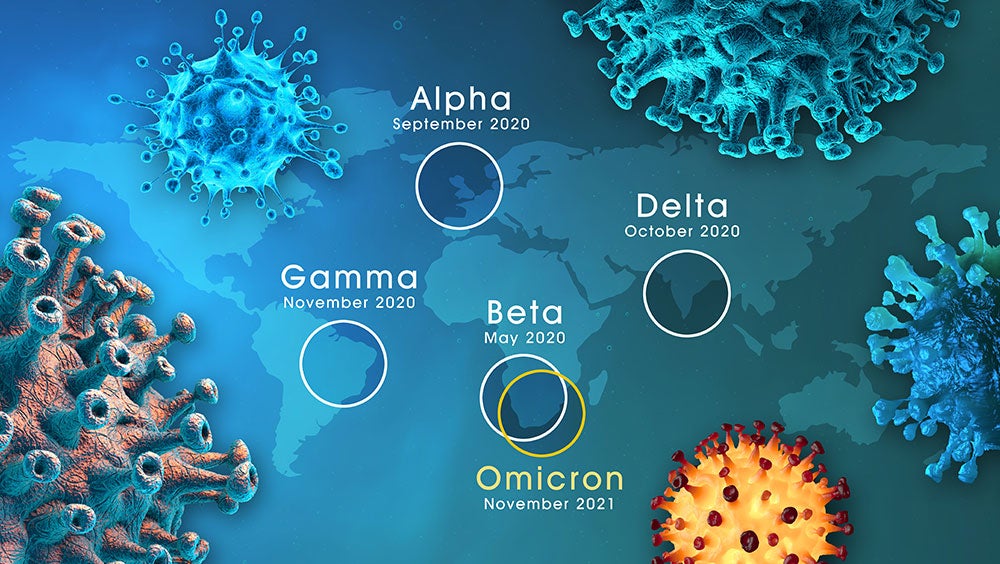On November 26th, the World Health Organization (WHO) designated a new SARS-CoV-2 variant, Omicron, a variant of concern1. Before beginning, I first want to applaud the scientists in South Africa for alerting WHO about this new variant, and also to reiterate that just because the variant was first identified in South Africa does not mean that it came from there. Their identifying it first speaks very highly to the surveillance methods they are conducting, and we in the scientific community are grateful for them. We are still learning about this new variant, and we are awaiting more information from the scientific community as well as governing health organizations. While we wait for answers to our questions, as an immunologist and an expert in cleaning and disinfecting, I want to share some things to be cautious about as we learn more about this new variant and a few reasons to be optimistic.

Be Suspicious of Early Predictions About Omicron’s Behavior
As with all new variants, the first piece of information we receive is what it is made of (genetically). In this case, we know that Omicron has the most mutations of any variant so far, and some of these mutations are shared with previous variants that have made them more transmissible and more able to evade the immune system.2 But predictions about a variant’s behavior cannot be made from these mutations, even if we have seen some of these changes before. The reason is that these changes influence each other. Think of each mutation like throwing stones in a pond to create a ripple — if you toss another stone it will change the pattern of the other ripples. Unfortunately, we will have to wait for more data and real experiments to truly understand the transmissibility and severity of Omicron.
Another thing to be cautious about are predictions of what will happen in the United States based on situations in other countries. For instance, South Africa is experiencing an outbreak caused by Omicron, but that does not necessarily mean that this will happen in the U.S. There are many differences between the landscape in South Africa and here. For example, vaccinations: only 25% of the population of South Africa is fully vaccinated, compared with 60% of the US population, and an additional 13% of the US population has had a booster dose.3 Another major difference is transmission levels before Omicron. Prior to Omicron, South Africa had lower circulating levels of SARS-CoV-2, whereas the US has been dealing with substantial transmission of the Delta variant for more than 6 months.3 To gain hold here, Omicron would have to be able to outcompete Delta and overcome vaccine immunity, and we don’t know if it can do either of those things at this point.
Even in the Worst-Case Scenario, We Are Not Starting from Scratch
New variants of SARS-CoV-2 will continue to emerge, and Omicron is unlikely to be the last of them. However, even in the face of this new variant and those to follow, there are many reasons to be optimistic.
- Immune protection from vaccines. The vaccines have continued to provide long-lasting protection from severe illness related to COVID, even with new variants. This is not likely to change with Omicron. We may see more infections, but protection from severe illness should remain.1
- Mitigation measures still in place in the U.S. In addition to vaccination, many US public health departments are still mandating and recommending wearing masks indoors, limiting large gatherings, and encouraging COVID testing. Additionally, the Biden administration has announced that the at-home rapid antigen tests for COVID will now be covered by private insurance, which will make them more accessible and help limit transmission.1
- Treatments for COVID-19. In the past year we have introduced multiple new treatments to help people already infected with SARS-CoV-2. Coming soon, the FDA may authorize two additional pill-based treatment regimens that sick people can take at home. This would make it easier to prevent severe illness in people who do become infected, which would lessen the impact of the virus.4
- Cleaning and disinfecting remain effective. There are strict product efficacy testing requirements established by the EPA to ensure a product can kill what a product claims it can. When a new virus emerges like COVID-19 and its variants, it’s not readily available for disinfectant efficacy testing in labs to meet EPA standards. In these situations, the EPA utilizes its Emerging Viral Pathogens Policy to quickly identify disinfectant products that can be used to kill the new virus based on that specific disinfectant’s efficacy against similar or more challenging viruses. For the COVID-19 virus variants, select disinfectant products have shown efficacy against similar COVID-19 variants and/or a harder-to-kill virus. EPA has stated that these products, which comprise List N, are expected to be effective against Omicron.5 We can still use these tools as we have before to prevent spread via surfaces, and this should hold true for variants past Omicron. To learn more about why our disinfectants will still work against variants, I recommend you read a blog by my colleague.
The Future with COVID-19: A New Player in Our Respiratory Illness Seasons
Before COVID-19, we were already familiar and accustomed to seasonal respiratory illnesses. This year, in addition to COVID-19, we have seen increased transmission of flu and colds as the economy has opened up and people gather together. The good news is that the same tools we have been using to fight COVID-19 will work for other respiratory viruses as well, and we hope these mitigation measures will continue in years to come:
- Hand hygiene. Washing hands can prevent the spread of illness-causing germs to surfaces and to other people.
- Wearing masks indoors and around unvaccinated people. Masks are a new addition in the US to prevent respiratory illness, but I hope they will stay in places like public transportation and doctor’s offices, as wearing masks can reduce the transmission of respiratory viruses by 50% or more.6
- Clean and disinfect high-touch surfaces. Disinfecting the riskiest surfaces can reduce the number of germs on the surface, and the likelihood that they can spread to someone and cause illness. Disinfection should be used as one part in a complete prevention strategy that includes wearing a mask, social distancing, and washing hands frequently.
- Vaccinations for flu and SARS-CoV-2. These remain highly effective at preventing severe illness caused by these viruses.1
As information about Omicron and other COVID-19 variants become available, it’s vital that we continue to follow CDC Guidance and remain steadfast in our efforts to combat this virus using proven methods for mitigation.
REFERENCES
1. Omicron variant: What you need to know. Centers for Disease Control and Prevention. Retrieved December 7, 2021, from https://www.cdc.gov/coronavirus/2019-ncov/variants/omicron-variant.html.
2. Covariants. Retrieved December 7, 2021, from https://covariants.org/variants/21K.Omicron.
3. Bhatia, G., Dutta, P. K., & McClure, J. (2021, December 8). Covid-19: The Latest Global Statistics, charts and maps. Reuters. Retrieved December 8, 2021, from https://graphics.reuters.com/world-coronavirus-tracker-and-maps/.
4. Zimmer, C. (2021, December 7). New Covid Pills Offer Hope as Omicron looms. The New York Times. Retrieved December 8, 2021, from https://www.nytimes.com/2021/12/07/science/merck-pfizer-covid-pill-treatment.html.
5. Do disinfectants kill newer variants of coronavirus? EPA. Retrieved December 8, 2021, from https://www.epa.gov/coronavirus/do-disinfectants-kill-newer-variants-coronavirus.
6. Science brief: Community use of masks to control the spread of SARS-COV-2. Centers for Disease Control and Prevention. Retrieved December 8, 2021, from https://www.cdc.gov/coronavirus/2019-ncov/science/science-briefs/masking-science-sars-cov2.html.


